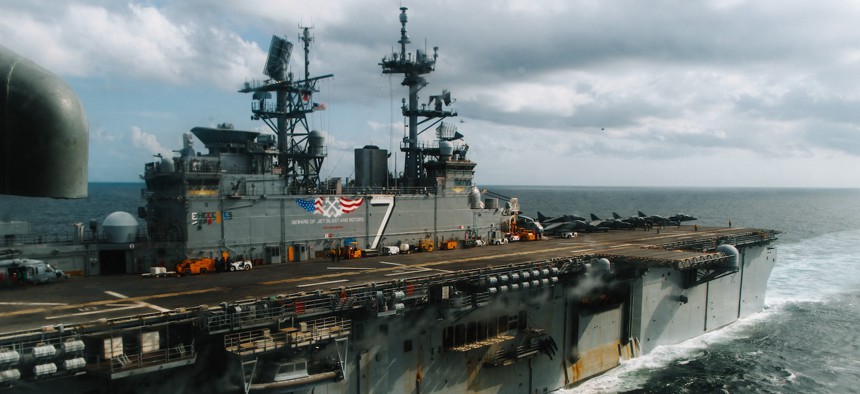
The Marine Corps wants the Navy to build more amphibious ships to support the Corps’ goal of keeping three amphibious ready groups at sea at all times—but the service still needs to figure out how many it needs, and funding for 2026 remains in flux.
The Marines long to return to the days when they had three amphibious ready groups, each carrying a Marine Expeditionary Unit, deployed at all times. It’s the Corps’ “north star,” Lt. Gen. Eric Austin, deputy commandant for combat development and integration, told lawmakers on Wednesday.
“Thirty-one is not adequate to get us to a 3.0 ARG-MEU presence,” Austin testified. “We need to understand what the requirements are to have the amphibious force that will source a continuous 3.0 ARG-MEUs presence. So we’re working through those processes right now.”
The comments come as Congress works on a budget plan for 2026. Defense spending is usually appropriated in a defense appropriations bill, but this year, one-time defense funding of approximately $150 billion is being considered in a megabill dubbed “The Big Beautiful Bill Act.”
The House-passed version includes about $695 million for a multi-ship amphibious warship contract, $2.1 billion for the San Antonio-class, and $3.7 billion for the America-class. The Senate Armed Services Committee’s version of the bill, released earlier this week, more than doubles the funding for a multi-ship contract—$1.47 billion—but omits funding for the San Antonio and America class ships.
Advance procurement funding could be used to keep production lines moving through 2026 as part of an existing multi-ship buy of four amphibious ships that promised $1 billion in savings.
“There were two amphibious ships that were set to be funded ahead of need and ahead of the ability to construct for 2026 that were cut,” a congressional official told Defense One. “Obviously, [SASC Chairman Sen. Roger Wicker] has been a champion of amphibs and has ensured we have money in the bill to complete the multi-ship deal, which will be a great savings for the taxpayer. This bill will ensure we are building amphibs as fast as possible, and the maintenance money will help get more existing amphibs out to sea.”
But any hiccup in funding could have lasting implications for the shipbuilding industry.
“There are all these suppliers that are dependent on business from the government, and in this case for the amphibious warship program. A lot of our suppliers are also suppliers on other programs, including submarines, aircraft carriers, and surface warships,” Paul Roden, who chairs the Amphibious Warship Industrial Base Coalition, previously told Defense One. “It’s all dependent on continuous funding from Congress. Even though the award for the bundle was authorized [for] four different ships—three LPDs and one LHA—if Congress doesn’t fund those per the schedule that they’ve laid out in that bundle package, then it would cause disruptions, cost increases, delays, layoffs, things like that.”
Program-level details on the full 2026 budget are still unknown, but the Trump administration has stressed the need for faster, better shipbuilding capacity. The House reconciliation bill includes about $33.7 billion for shipbuilding, while the Senate’s version has a shipbuilding topline of about $29 billion, shifting about $4 billion in funding across other priorities like unmanned systems.
“The military advancements that will result from this bill are indeed historic and their importance cannot be overstated,” Wicker, R-Miss., told reporters during a Defense Writers Group event. “We feel we’re committed to peace through strength. This is an area of the reconciliation bill where the House and Senate are very, very close in the provisions.”
About half of the amphibious ship fleet is in disrepair—and some have been unavailable for years at a time, according to a December 2024 Government Accountability Office report.
“Our ARG-MEUs are our most flexible and responsive tools,” Austin told lawmakers. “They are critical to our national interests and indispensable to our combatant commanders.”
But persistent problems like maintenance backlogs and delayed production have left the service’s seven MEUs without enough ARGs to support a constant deployment schedule.
“It takes a lot to be able to sustain that, to be able to field that. And it starts initially, in my mind, with making sure we have the requisite number of amphibious ships. And we know that is a hard, hard place to be,” Rep. Rob Wittman, R-Va., the committee’s vice chairman, said during the House Armed Services Subcommittee on Seapower and Projection Forces hearing.
Congress has mandated that the Navy have 31 amphibious ships at all times, to support the Marines, though the Corps says they’ll need more than that. What they haven’t said is exactly how many they’ll need.
Austin said the goal is to “fix what we have and buy what we need,” which includes evaluating mid-life upgrades for the [landing platform dock] fleet and possibly “extending one of our current [landing helicopter dock] Wasp-class to meet the 10-ship big-deck minimum requirement.”
Another problem: The Navy is decommissioning amphibs faster than they can build them.
Wittman said the situation is akin to “a track meet that it’s hard to win when your competition is running faster than you are.”
Vice Adm. James Pitts, deputy chief of naval operations for warfighting requirements and capabilities, agreed, but noted the Navy is testing new ways to keep ships on a maintenance schedule.
“The procurement piece—we’re actually in a good position, I think. It’s the maintenance piece that we’ve got work to do, and we are doing it,” Pitts testified.
In what it calls “signature availability pilots,” the Navy has been experimenting with defining a comprehensive list of maintenance tasks more than a year before the work starts.
“We basically lock down the work package much sooner, at like 500 days before we start it. And then go to contract at 360 days before we start it, so that the maintenance team can get all the material, be better prepared, and then we can get our amphibious ships in and out of maintenance so that the Marines can use them for training,” Pitts testified.
Still, Wittman pressed the Navy to do a better job of planning its amphibious ship maintenance.
“If you don’t POM for it, it’s not going to happen, because it shows that it’s not a priority there. So my big ask of the Navy is…make sure your POM includes maintenance for amphibs. If it does not, we will never, ever get there. And I’m going to implore you to do that. If I don’t see a request in the POM for amphib maintenance. I—believe me—you will be hearing back from me,” Wittman said.
The post How will budget talks will shape Marines’ amphibious fleet plans appeared first on Defense One.




